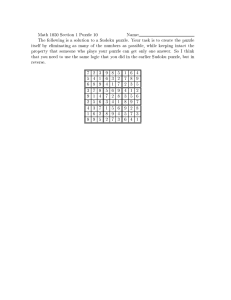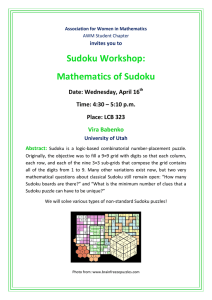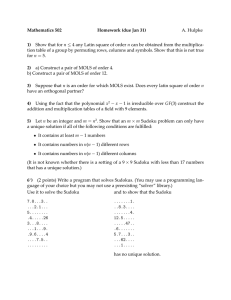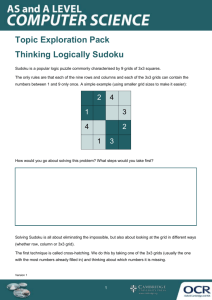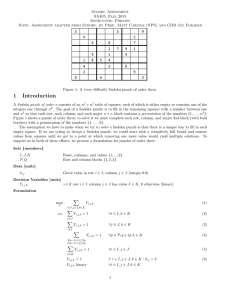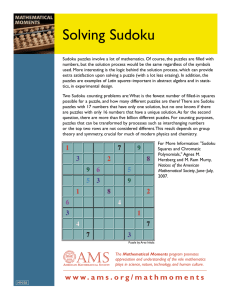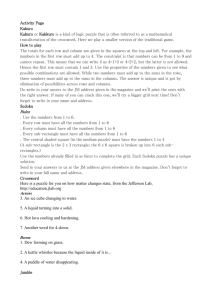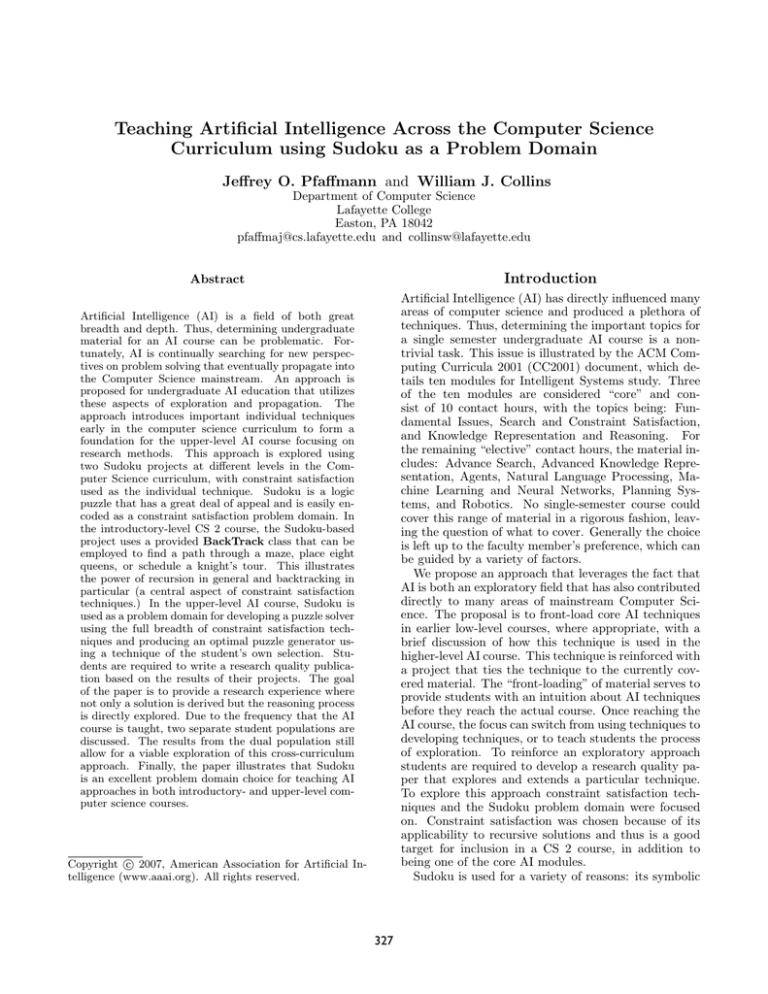
Teaching Artificial Intelligence Across the Computer Science
Curriculum using Sudoku as a Problem Domain
Jeffrey O. Pfaffmann and William J. Collins
Department of Computer Science
Lafayette College
Easton, PA 18042
pfaffmaj@cs.lafayette.edu and collinsw@lafayette.edu
Introduction
Abstract
Artificial Intelligence (AI) has directly influenced many
areas of computer science and produced a plethora of
techniques. Thus, determining the important topics for
a single semester undergraduate AI course is a nontrivial task. This issue is illustrated by the ACM Computing Curricula 2001 (CC2001) document, which details ten modules for Intelligent Systems study. Three
of the ten modules are considered “core” and consist of 10 contact hours, with the topics being: Fundamental Issues, Search and Constraint Satisfaction,
and Knowledge Representation and Reasoning. For
the remaining “elective” contact hours, the material includes: Advance Search, Advanced Knowledge Representation, Agents, Natural Language Processing, Machine Learning and Neural Networks, Planning Systems, and Robotics. No single-semester course could
cover this range of material in a rigorous fashion, leaving the question of what to cover. Generally the choice
is left up to the faculty member’s preference, which can
be guided by a variety of factors.
We propose an approach that leverages the fact that
AI is both an exploratory field that has also contributed
directly to many areas of mainstream Computer Science. The proposal is to front-load core AI techniques
in earlier low-level courses, where appropriate, with a
brief discussion of how this technique is used in the
higher-level AI course. This technique is reinforced with
a project that ties the technique to the currently covered material. The “front-loading” of material serves to
provide students with an intuition about AI techniques
before they reach the actual course. Once reaching the
AI course, the focus can switch from using techniques to
developing techniques, or to teach students the process
of exploration. To reinforce an exploratory approach
students are required to develop a research quality paper that explores and extends a particular technique.
To explore this approach constraint satisfaction techniques and the Sudoku problem domain were focused
on. Constraint satisfaction was chosen because of its
applicability to recursive solutions and thus is a good
target for inclusion in a CS 2 course, in addition to
being one of the core AI modules.
Sudoku is used for a variety of reasons: its symbolic
Artificial Intelligence (AI) is a field of both great
breadth and depth. Thus, determining undergraduate
material for an AI course can be problematic. Fortunately, AI is continually searching for new perspectives on problem solving that eventually propagate into
the Computer Science mainstream. An approach is
proposed for undergraduate AI education that utilizes
these aspects of exploration and propagation. The
approach introduces important individual techniques
early in the computer science curriculum to form a
foundation for the upper-level AI course focusing on
research methods. This approach is explored using
two Sudoku projects at different levels in the Computer Science curriculum, with constraint satisfaction
used as the individual technique. Sudoku is a logic
puzzle that has a great deal of appeal and is easily encoded as a constraint satisfaction problem domain. In
the introductory-level CS 2 course, the Sudoku-based
project uses a provided BackTrack class that can be
employed to find a path through a maze, place eight
queens, or schedule a knight’s tour. This illustrates
the power of recursion in general and backtracking in
particular (a central aspect of constraint satisfaction
techniques.) In the upper-level AI course, Sudoku is
used as a problem domain for developing a puzzle solver
using the full breadth of constraint satisfaction techniques and producing an optimal puzzle generator using a technique of the student’s own selection. Students are required to write a research quality publication based on the results of their projects. The goal
of the paper is to provide a research experience where
not only a solution is derived but the reasoning process
is directly explored. Due to the frequency that the AI
course is taught, two separate student populations are
discussed. The results from the dual population still
allow for a viable exploration of this cross-curriculum
approach. Finally, the paper illustrates that Sudoku
is an excellent problem domain choice for teaching AI
approaches in both introductory- and upper-level computer science courses.
c 2007, American Association for Artificial InCopyright telligence (www.aaai.org). All rights reserved.
327
nature allows puzzles to be easily encoded as constraint
satisfaction problems, puzzles exhibit a scalable complexity depending on the problem that is given, and
these puzzles have a certain public popularity (Delahaye 2006). The literature has also suggested Sudoku
as a good problem for course work (Edgington 2006) as
well as providing several implementations, including:
Python (Park 2006), Fortran (Metcalf 2006), and LaTeX (Wilson 2006). Constraint satisfaction researchers
are also begining to use Sudoku as problem domain in
their work (Simonis 2005).
Sudoku is a puzzle game where a player must fill in
blank squares on a 9-by-9 grid so that certain requirements, or constraints, are maintained. The name is
derived from a much longer Japanese phrase that translates to “the digits must remain single” (Wikipedia
2006). The goal of the game is to fill in every empty
grid location with a number from 1 thru 9 so that the
values in each column, row, and 3-by-3 subregion are
unique. The subregions are determined by subdividing the 9-by-9 grid into 9 3-by-3 mini-grids, as shown
in Figure 1. Sudoku puzzles are simple to understand
but can be non-trivial to solve, making them a good
problem domain for computer science education in general. This complexity is evident in the fact that there
are approximately 6.671 × 1021 distinct Sudoku solutions (Felgenhauer & Jarvis 2006).
filled it, which can be a great number or very few depending on the puzzle complexity. Typically, a Sudoku
puzzle will have a single solution, but if a puzzle is
poorly designed then multiple solutions are possible,
which is a feature that can be use as part of a class
assignment.
There are a variety of logical methods for solving Sudoku puzzles. One such method is to examine a single
grid location and determine all the possible values it
may contain. If there is only one possible value then
enter that value, otherwise note the possible values for
future reference. For example, consider the possible
values for the upper-left grid-location, or location (0,
0) if the row and column indexes start at 0. The only
valid values for this location, given the current board
configuration, is 3 by process of elimination. This can
be determined by examining the location in column 0
and row 0, which are the values 1, 2, 4, 5, 6, 7, 8,
and 9 but not 3. An alternate approach is to examine one particular value, for example 1, and determine
where this value must be placed given the constraints
imposed by the locations that already contain the same
value. Using the example value 1, it can be seen that
the upper-right subgrid does not contain a 1. Then by
examining columns 6 and 7, it can be seen the subgrids
below the upper-right subgrid contain a 1 in columns
6 and 7 allowing only column 8 to contain the value
1. Finally, column 8 in the upper-right subgrid can be
seen to contain only one empty position, grid location
(1, 8) that must then contain the value 1.
The Sudoku Puzzle
Sudoku, originally named Number Place, was created
by Howard Garnes in 1979 and first published later that
year in Dell Pencil and Puzzle Games. At first, interest
in Sudoku was minimal until it reappeared in print and
was given its current name by the Japanese publisher
Nikoli in 1984. The internationalization of the craze
began when Wayne Gould of Pappacom developed a
program to create Sudoku puzzles and grade their level
of difficulty (Shortz 2005).
4
5
7
2
1
2
8
3
6
5
3
7
2
8
7
9
8
1
6
5
4
2
8
6
7
3
6
5
7
5
9
1
2
8
6
2
6
5
4
7
8
3
9
1
1
8
9
3
2
6
7
5
4
6
9
4
7
3
5
1
2
8
5
3
1
8
4
2
9
6
7
7
2
8
1
6
9
5
4
3
8
7
2
9
1
4
6
3
5
4
1
6
2
5
3
8
7
9
9
5
3
6
8
7
4
1
2
To solve most well-designed Sudoku puzzles, logic
strategies can be used to propagate or resolve constraints imposed by currently existing values. But it
is an open question whether all Sudoku puzzles with
a unique solution can be solved by only constraint
propagation, that is, without the use of backtracking.
Mepham (Mepham 2005) has devised several “diabolical Sudoku” puzzles which, at least when they were
released, could not be solved using known constraint
propagation techniques and no backtracking. One such
diabolical Sudoku puzzle is given in Figure 3.
For pencil-and-paper Sudoku solvers, backtracking is
9
2
4
Figure 2: The solution to the Sudoku puzzle in Figure 1.
1
6
3
9
1
Figure 1: A sample Sudoku puzzle.
Figure 1 provides an example to examine how one
would go about solving a Sudoku puzzle with penciland-paper. The puzzle starts with certain locations
328
1
9
7
8
7
9
7
4
6
2
9
4
1
9
8
5
4
3
5
import java.util.*;
public class BackTrack
{
protected Application app;
3
7
4
5
2
which had been assigned in previous semesters). The
fact that the BackTrack class and Application interface are re-usable helps students to appreciate backtracking as a general-purpose tool for solving a variety
of problems.
3
8
6
9
/**
* Initializes this BackTrack object from an application.
*
* @param app the application
*/
public BackTrack (Application app)
{
this.app = app;
} // constructor
Figure 3: A “diabolical Sudoku” puzzle, whose solution is unattainable using only (currently available) constraint propagation techniques.
unattractive as a single strategy, even for those with
great patience and a large eraser. Some Sudoku puzzles
that can be straightforwardly solved with backtracking require over 100,000 backtracks without constraint
propagation or selection heuristics. But programmatically, the simplicity of backtracking makes it appealing, even without more complex constraint-satistfaction
techniques. Students with only a minimal knowledge of
Sudoku can develop a program to solve any Sudoku puzzle that has a unique solution. This ability illustrates
the power of recursion in general and backtracking in
particular.
/**
* Attempts to reach a goal through a given position.
*
* @param pos the given position.
*
* @return true if the attempt succeeds;
* otherwise, false.
*/
public boolean tryToReachGoal (Position pos)
{
Iterator<Position> itr = app.iterator (pos);
while (itr.hasNext())
{
pos = itr.next();
if (app.isOK (pos))
{
app.markAsPossible (pos);
if (app.isGoal (pos) || tryToReachGoal (pos))
return true;
app.markAsDeadEnd (pos);
} // pos may be on a path to a goal
} // while
return false;
} // method tryToReachGoal
} // class BackTrack
CS 2 SUDOKU PROJECT
In the fall semester of 2005, the students in the CS 2
course at Lafayette College were assigned a programming project to develop a Sudoku-puzzle solver. In
the course, there were 21 students: 15 in Electrical
and Computer Engineering, 4 in Mathematics, and 2
in Computer Science. The language used in the class
is Java. The project was assigned at the end of the
chapter on recursion, and a case study of backtracking to find a path through a maze had been covered during class (Collins 2005). The following BackTrack class, based on a similar class in Noonan (Noonan 2000), utilizes a generalized backtracking algorithm
from Wirth (Wirth 1976).
A user of the BackTrack class supplies:
For the Sudoku project, students were required to use
the BackTrack class and Application interface, as is.
They had some flexibility with regard to the Position
class: They could use the Position class from the maze
project, or modify that class by adding a digit field
(with values in the range from 0 through 9, inclusive)
as well as row and column fields. Then an iteration
over the positions accessible from a given position could
simply iterate over the possible digits that the given
position could take on.
The driver entailed a considerable amount of errorchecking; for example, if the initial puzzle had two
copies of the digit 7 in the same column, or if the puzzle
1. a Position class to define what position means for
this application (for example, in the maze case study,
a position is simply a row and column);
2. a class that implements the Application interface;
for the maze case study, the Maze class included the
necessary details for finding a path;
3. a driver class to run the project, including input and
output.
The same set up can be used for the Eight Queens
problem and for the Knights Tour problem (each of
329
1
2
3
4
5
6
7
8
For the Sudoku solver, the students were required
to use constraint satisfaction techniques as discussed in
class, which is also detailed in the class textbook by
Russell and Norvig (Russell & Norvig 2003). The backtracking algorithm is common to the constraint satisfaction techniques presented in class, which is also similar
to the BackTrack class presented above. The class
text also introduces the idea of using the number of
constraint validation checks performed as a metric of
program efficiency, allowing the comparison of the different constraint satisfaction techniques. To implement
this metric in the previously provided code, a counter
would be added to the isOK (pos) method to track
the number of times this method is called. Using this
metric students could create a solver with the primary
purpose of comparing different constraint satisfaction
techniques. For the Sudoku project students were required to implement the following techniques: basic
backtracking, backtracking with a variable or value ordering heuristic, forward check, forward checking with
a variable or value ordering heuristic, and a constraint
propagation technique. The resulting Sudoku puzzle
solver program is a simple batch-program that accepts
configuration parameters and a puzzle to solve. Once
the program was complete, it produced a puzzle solution and printed the performance metrics.
Backtracking is included in the list of required techniques to provide a baseline for comparing the other
techniques to. The remaining techniques are well
known methods commonly associated with constraint
satisfaction problem solvers. Variable and value ordering heuristics attempt to reduce the search space by
selecting the variable or value that is most constrained
and thus have the smallest branching factor. Forward
checking maintains information about each unassigned
variable and updates this information anytime a value
is placed. If a locations become invalid then forward
checking will detect the constraint violation and respond before basic backtracking would. Forward checking can be combined with variable and value ordering
heuristics, with the minimum remain values heuristic
(MRV) the most common. MRV is a variable selection
heuristic where the variable with the fewest possible
values is selected first, which is similar one of the paperand-pencil techniques discussed previously. MRV is a
good match with forward checking because the same
information is computed for both, while producing a
performance neither technique can produce alone. Constraint propagation is a technique where the constraints
between the variables are searched to a limited depth
to provide information for the basic backtracking to be
performed more efficiently. Constraint propagation can
be implemented as a preprocessor or integral part of
the backtracking algorithm, with the later being a more
complex design but a more effective approach. It should
be noted that with the use of constraint propagation the
processing time is shifted from the time searching the
variable space to searching the constraint space, which
will not show up in the required metric. Therefore, the
9
Figure 4: An initial Sudoku configuration for which no
solution is possible.
had no solution, as shown in Figure 4.
The project also had an extra-credit component: a
bonus, worth 50% of the project grade, went to the
first student whose project could detect if a puzzle had
more than one solution. A sample program is available
to instructors on request.
CS 2 RESULTS
Of the 21 students in the CS 2 course, 14 completed the
project, and most of those utilized the hint of expanding
the Position class to simplify the iterations. In anonymous comments, there was an even split among those
who enjoyed the project, those who detested it, and
those who were neutral. Also, two students complained
that the BackTrack class and Application interface
were too confining: They wanted the flexibility to develop an ad-hoc solution. Only four of the students in
the class had heard of Sudoku before the project was
assigned, and only two had played Sudoku.
AI SUDOKU PROJECT
In the fall semester of 2005 the Artificial Intelligence
class (CS 420) was assigned a more expansive project,
which consisted of three parts: a Sudoku solver, a Sudoku puzzle generator, and a 10-page conference quality
paper based on the student’s work. The class consisted
of 16 students at either a junior or senior standing, with
everyone having completed the core computer science
curriculum. The Artificial Intelligence class is taught
with weekly labs and two large projects that span 4-5
weeks. These large projects serve to provide students a
research opportunity, thus some aspects were well specified while other aspects were more open-ended. One of
the topics covered in Artificial Intelligence is constraint
satisfaction problems, which is a general-purpose problem solving technique where the problem is formulated
in terms of variables, the legal values for each variable,
and the constraints between each variable. For Sudoku
each grid location represents a variable, each variable
will contain a value 1 through 9, and the value in each
variable is regulated with three simple constraints.
330
students were also encouraged to develop other metrics
to determined their implementation’s efficiency.
Once the solver is completed, the students perform
experiments using several Sudoku puzzles of varying
complexities to determine the general utility of the five
different algorithms. Often in AI research, only part of
the research effort involves producing a working solution, while the real work is in understanding why the
system functions the way it does and how it relates to
other solutions. Here students do this by comparing the
different techniques to the basic backtracking approach
and compare their implementations to the designs of
others in the class.
For the second part, a Sudoku puzzle generator is required, which is the open-ended aspect of the project.
Here students are required to take a Sukoku solution
and produce a puzzle that has the most values removed
and is still capable of producing only a single solution,
or a minimum unique puzzle. The puzzle generator is
a non-trivial problem that the students were given because there is no immediately obvious solution (other
than brute force random value removal). The question then becomes, is there an elegant way of using the
constraints to remove values from the puzzle solution
so that the minimum sized puzzle is found that will
still generate a single solution. It is also important to
note that there will be multiple suboptimal results, and
the problem becomes finding the global optimum (and
whether or not there are several equivalent global optimums).
For the puzzle generator, the students were allowed to
try any approach that they prefered, however, they were
discouraged from using a purely brute force approach
of randomly removing values. Students were also made
aware that they would be rewarded for creativity and
not punished for failure, that is, they were given room
to explore without fear that they would loose points.
This aspect of the Sudoku project seeks to stimulate the
student’s creativity, or the ability to try new avenues,
which is an important aspect of any research experience.
The final part of the project, students are required to
produce a 10-page conference quality research paper,
using the ACM special interest group formatting. In
the paper, students discussed their methodology, algorithm implementation, results and lessons learned. Students at Lafayette College do a great deal of writing,
but much of it is outside of the department and does not
follow the format that is common for their chosen field
of study. One goal of the Artificial Intelligence class is
to give students the opportunity to become aquatinted
with a style that is common to computer science. To
facilitate this goal, students were required to use templates provided by the ACM for conference proceedings.
Additionally the students were required to minimally
have the following sections.
to a casual reader with a computer science background.
• Formal Description – Formally describe the problem and the algorithms used to solve it.
• System Performance – Describe project methodology for determining system performance and quantitatively discuss its performance.
• Conclusion – Reintroduce the problem/approach,
qualitatively discuss the performance of the system,
and draw-out any conclusions or lessons that may
have been learned.
Students were also provided example constraint satisfaction research papers, as well as, being encouraged
search out their own examples. Students were graded
primarily on publication quality, as is any researcher
who is submitting an article to a conference. The
condition of the source code, i.e., formating and comments, were expected to adhere to a certain standard,
which could negatively impact a student’s grade if these
standards were not maintained. Furthermore, nonfunctioning and incorrectly-functioning programs could
also negatively impact a student’s project grade. Again,
the goal of the project is to provide students with a research experience where the student develops a software
infrastructure, explores new problem solving directions,
and generates a document to summarize the results. In
future versions of this class a double-blind review process will be added, where each student will be given
two submissions that they must review, comment, and
accept or reject for a hypothetical conference.
AI Project RESULTS
Of the 16 students, all but two students submitted
a complete article with correct fully functioning programs. For the two students, one submitted a correct
sudoku puzzle solver and generator, while the other submitted only a puzzle solver. Each puzzle solver was
run with a common set of five different Sudoku puzzles
and the metrics were compared. These metrics were
presented to the class and discussed during a class period reserved for recapping the project experience. As
would be expected, the metrics derived from each program varied greatly for the techniques that extended
the basic backtracking algorithm, while the metrics for
backtracking alone typically were the same.
The puzzle generator results varied greatly, with none
of the submitted solutions able to produce the minimum
unique puzzle. The bulk of the students used an optimized value removal technique, where they would select
variables based on some heuristic then run their solver
to see if the solution was still unique. The remainder of
the students used stochastic techniques, such as genetic
algorithms or simulated annealing. This second body
of students consistently obtained better results than did
the students using removal techniques. But again, the
second group also used their solver to detect if the puzzle generated the same unique solution. It should be
• Abstract – The paper should start with a 500-word
abstract summarizing the work.
• Introduction – Introduce the problem and approach
331
noted that this technique is error prone because multiple solutions might not be detected, but given the class
time-line this was an acceptable approach.
The greatest project success was the general high
quality of the submitted articles, which typically came
closer to a conference quality paper than what might
be expected for a first attempt at formulating such a
document. Overall, students were able to assimilate
the lessons learned from their previous courses in algorithms and statistics, critically examine their own work,
and presenting that work in the correct light. From a
formatting perspective the articles were typically well
organized and presented in a way the reader could easily understand what the author had done. At this point
the impact of introducing backtracking in CS 2 could
not be evaluated in terms of how that influence the AI
project, as these courses were held in parallel. But this
information will make itself available during the Fall
2007 semester when the Artificial Intelligence course is
offered again.
Sudoku is well suited for teaching recursion in the introductory computer science curriculum, as well as, providing upper-level students with a solid research experience in Artificial Intelligence courses. Thus, the
two presented Sudoku problems illustrate how Artificial Intelligence techniques can be taught across the
Computer Science curriculum, allowing for students to
understand the broad issues of an expansive field. Finally, it is expected that these results will be further
supported in the next iteration of the uppper-level AI
course. For this later course, the students will consist
of those exposed to constraint satisfaction in the lowerlevel CS 2 course.
References
CC2001. Computing Curricula 2001: Computer science report of the joint task force on computing curricula. http://www.acm.org/education/curricula.html.
Collins, W. J. 2005. Data Structures and the Java
Collections Framework. New York, NY: McGraw-Hill,
2nd edition.
Delahaye, J.-P. 2006. The science behind Sudoku.
Scientific American 80–87.
Edgington, J. 2006. Solving Sudoku puzzles: Nifty
course assignments. J. Comput. Small Coll. 21(4):90–
91.
Felgenhauer, B., and Jarvis, F. 2006. Mathematics of
Sudoku I. Mathematical Spectrum 39(1):15–22.
Mepham, M. 2005. Farewell to ariadne s thread.
http://www.sudoku.org.uk/goodbye.htm.
Metcalf, M. 2006. A Sudoku program in Fortran 95.
SIGPLAN Fortran Forum 25(1):4–7.
Noonan, R. 2000. An Object-Oriented view of backtracking. In Proceedings of the 31st SIGCSE Technical
Symposium on Computer Science Education, 362–366.
Park, C.
2006.
Why not Python?, part 2.
http://www.linuxjournal.com/article/8729.
Russell, S., and Norvig, P. 2003. Aritificial Intelligence: A Modern Approach. Englewood Cliffs, NJ:
Prentice-Hall, Inc., 2/e edition.
Shortz, W. 2005. Sudoku Easy Presented by Will
Shortz. New York, NY: St. Martin’s Griffin.
Simonis, H. 2005. Sudoku as a constraint problem. In
Hnich, B.; Prosser, P.; and Smith, B., eds., Proc. 4th
Int. Works. Modelling and Reformulating Constraint
Satisfaction Problems, 13–27.
Wikipedia. 2006. Sudoku entry.
http://en.wikipedia.org/wiki/Sudoku.
Wilson, P. 2006. Sudoku bundle for displaying, solving
and generating Sudoku puzzles.
http://www.ctan.org/tex-archive/macros/latex/
contrib/sudokubundle/sudokubundle.pdf.
Wirth, N. 1976. Algorithms + Data Structures =
Programs. Englewood Cliffs, NJ: Prentice-Hall, Inc.
CONCLUSIONS
In the CS 2 course, the goal of the project was to illustrate the generality of backtracking as a problemsolving tool. Students with a minimal knowledge of Sudoku were able to solve any Sudoku puzzle by utilizing
an already available BackTrack class, an appropriate
implementation of the Application interface, a fairly
small Position class, and a driver. As such, the project
was a success. For the two students who found the required framework constraining, there was not much recourse: An ad-hoc solution without backtracking would
not have met the goal of the project, would not have allowed the solution of “diabolical” Sudoku puzzles, and
would have either required a substantial knowledge of
Sudoku or tempted students to scour the Web for an
already existing program.
For the Artificial Intelligence course the goal is to use
Sudoku as a problem domain for a constraint satisfaction project where the students can have a real research
experience. They were required to create a puzzle solver
using a variety of constraint satisfaction techniques and
a puzzle generator using a technique of their own determination. Then using the solver and generator results,
students wrote a conference quality research paper. In
the paper, the solver provided a system where students
needed to explain why it worked the way it did, and the
generator provided an open-ended task where students
could explore the creative process inherent in research.
Based on paper quality, the project achieved its goals
by forcing the students to begin thinking in a research
mode, as opposed to an assignment mode. This was especially seen in the lab, where students began to have
last minute “revelations” that would cause students to
begin new experiments on an algorithm variation for
additional results.
These results show Sudoku is a very natural fit
for backtracking and associated constraint satisfaction
techniques. Additionally, the presented results indicate
332


